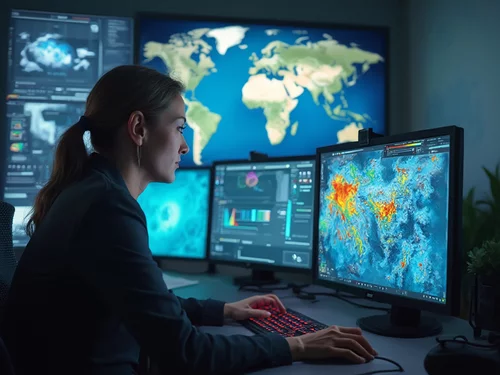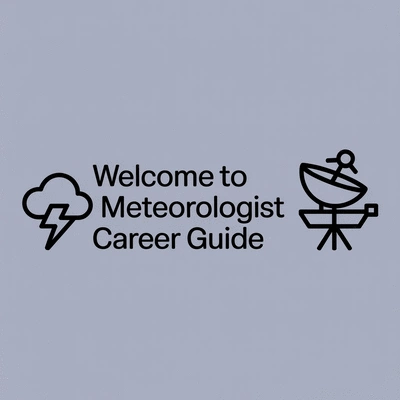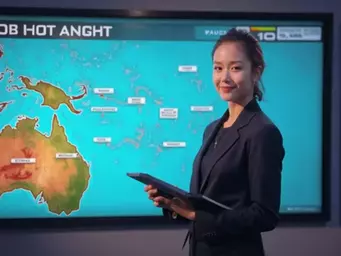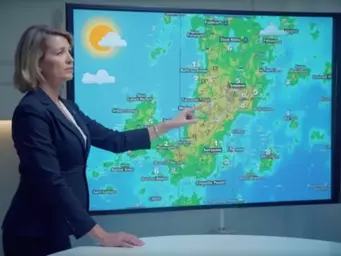Have you ever wondered how meteorologists accurately predict weather patterns? The tools and technologies in meteorology are not just essential; they are revolutionary in our approach to understanding climate challenges. Dive into the vital role these instruments play in shaping forecasts and keeping communities safe.
What You Will Learn
- Meteorological instruments provide real-time data critical for accurate forecasts.
- Technology helps monitor and address unique climate challenges faced in Australia, such as droughts and flooding.
- Key instruments like barometers, anemometers, and rain gauges are vital for understanding weather changes.
- Emerging trends, including AI and mobile apps, are enhancing public engagement with weather updates.
- Continuous learning and mastery of tools are essential for success in the dynamic field of meteorology.
Key Meteorological Instruments and Emerging Trends
This visual highlights essential tools used in Australian meteorology and future technological advancements.
Essential Weather Instruments
- Barometers: Measure atmospheric pressure.
- Anemometers: Gauge wind speed & direction.
- Rain Gauges: Collect precipitation data.
Emerging Trends in Meteorology
- AI & Machine Learning: For data analysis.
- Remote Sensing: More affordable tech.
- Mobile Apps: Enhanced weather updates.
Understanding the Vital Role of Tools in Australian Meteorology
In the field of meteorology, tools and instruments play a crucial role in understanding and predicting weather patterns. As someone who has dedicated years to studying the atmosphere, I can attest to the importance of these tools in delivering accurate forecasts. Without them, we would struggle to make informed decisions about severe weather events, agriculture, and even daily activities. In Australia, where our weather can shift dramatically, having the right meteorological instruments is vital.
But why do we rely on these instruments so heavily? Well, they help us collect vital data, analyze atmospheric conditions, and ultimately enhance our forecasting abilities. Let’s dive into the reasons why meteorological instruments matter and how they address the unique challenges we face in Australia.
Why Meteorological Instruments Matter for Weather Predictions
Meteorological instruments are the backbone of weather forecasting. They capture data from various atmospheric layers to help us understand our environment better. Here are some key reasons why these instruments are indispensable:
- They provide real-time data that is essential for accurate short- and long-term forecasts.
- They help identify patterns in weather changes, allowing meteorologists to predict severe weather events.
- They enhance our understanding of climate variability and trends over time.
By utilizing the right tools, we can improve our weather predictions and assist communities in preparing for upcoming challenges. It’s about making informed decisions that can save lives and reduce economic impacts! For more information on how these tools are used, refer to resources like the NOAA Weather and Climate Toolkit, which provides a suite of tools for accessing and visualizing climate data.
The Importance of Technology in Addressing Australian Climate Challenges
Australia faces distinct climate challenges, from droughts to flooding, and the role of technology in addressing these issues is paramount. Advanced meteorological instruments allow us to monitor these challenges effectively. Here are some of the technologies that are reshaping our approach:
- Remote sensing technologies for monitoring ocean temperatures and atmospheric conditions.
- Automated weather stations that provide localized data efficiently.
- Satellite imagery for tracking large-scale weather patterns.
These tools not only help us forecast weather better but also contribute to ongoing climate research, ensuring we stay ahead of potential threats. I believe that as we continue to develop and harness these technologies, we can face climate challenges head-on.
Key Weather Instrumentation Used in Australian Meteorology
The variety of tools at our disposal in the field of meteorology can be overwhelming, yet they are all essential for accurate analysis. Here are some key weather instruments widely used across Australia:
- Barometers: Measure atmospheric pressure, essential for forecasting weather changes.
- Anemometers: Gauge wind speed and direction, which are critical for understanding storm systems.
- Rain gauges: Collect data on precipitation, helping to predict flooding and agricultural needs.
Familiarizing ourselves with these instruments not only enhances our forecasting abilities but also leads to a deeper understanding of the atmospheric phenomena we study. At the Meteorologist Career Guide, we aim to equip aspiring meteorologists with insights into these invaluable tools, paving the way for successful careers in our field!
Pro Tip
Did you know? Investing time in mastering data visualization tools can significantly enhance your forecasting skills. By presenting complex meteorological data in an easy-to-understand format, you can better communicate your findings and predictions to the public, improving community preparedness and response to weather events.
Looking Ahead: The Future of Meteorological Tools in Australia
As the field of meteorology continues to evolve, we must keep an eye on the emerging trends that will shape the future of weather forecasting in Australia. Technological advancements are not just enhancing our current forecasting capabilities; they are redefining how we interpret and respond to weather events. It's crucial to understand how these innovations will impact our profession and the environment we operate in!
One key trend is the integration of more advanced machine learning algorithms into weather prediction models. These algorithms can analyze vast datasets to uncover patterns that humans might miss, leading to improved forecasting accuracy. Additionally, the proliferation of personal weather stations is making localized weather information more accessible and relevant for Australians.
Emerging Trends in Meteorological Technology and Their Implications
- Increased reliance on artificial intelligence for data analysis.
- Development of more affordable remote sensing technologies.
- Greater integration of mobile apps for weather updates.
- Advancements in public engagement tools for weather education.
These developments indicate a shift towards a more interactive and informed public regarding weather events. As meteorologists, we must adapt to these changes and leverage them to enhance our communication strategies with the public.
Preparing for the Impact of Climate Change on Weather Forecasting
Climate change is undeniably altering our weather patterns, making it essential for us to prepare for its impacts on forecasting. As we face more extreme weather events, our tools and techniques must evolve accordingly. The adoption of innovative technologies will be key in adapting to these changes.
For instance, utilizing data analytics can help identify trends related to climate change, allowing us to adjust our forecasting practices. Furthermore, it's vital to collaborate with environmental scientists to incorporate climate models into our meteorological tools. This approach can aid in creating more accurate predictions for extreme weather events, which is increasingly urgent in our changing climate. The State of the Climate report from the American Meteorological Society offers further insights into these global trends.
Advancements in Weather Visualization Tools for Better Public Communication
Another exciting area of development is in weather visualization tools. Enhanced graphics and real-time data presentation can make complex meteorological information more accessible to the general public. Visual storytelling through these tools can engage communities and raise awareness about severe weather preparedness.
With user-friendly interfaces and engaging visuals, we can effectively communicate forecasts and warnings, making it easier for individuals to understand the implications of the weather on their daily lives. It's all about making the science accessible and actionable!
Emphasizing the Importance of Mastery in Meteorological Tools
Mastering the tools of the trade is crucial for any aspiring meteorologist. As I often emphasize at the Meteorologist Career Guide, understanding how to use these instruments effectively can lead to successful weather predictions, which are vital for public safety and environmental management.
Whether it’s mastering Doppler radar technology or learning to interpret satellite imagery, continuous improvement in these areas will enhance our forecasting capabilities. Engaging with current meteorologists in the field can provide insights and tips that are invaluable for your growth!
How Mastering Technology Drives Successful Weather Predictions
- Staying updated with the latest technologies and tools.
- Practicing with real-time weather data to refine skills.
- Participating in workshops and training programs.
- Networking with professionals to share knowledge and techniques.
As we focus on mastery, remember that the journey in meteorology is one of constant learning. Embrace the challenges that come with new technology!
Encouraging Continuous Learning and Adaptation in Meteorology
Continuous learning is not just beneficial; it’s essential in a field as dynamic as meteorology. The landscape is ever-changing, and staying ahead means being open to new information and techniques. I encourage you to seek out mentorships, attend conferences, or engage in online courses to keep your skills sharp.
By fostering a mindset of adaptation and growth, we can ensure that we’re using the best tools available to serve our communities effectively. Remember, every piece of knowledge you gain adds value to your career and enhances your contributions to the field!
The Importance of Weather Observation Networks in Data Collection
Weather observation networks play a crucial role in gathering accurate data for forecasting. These networks provide real-time data that can significantly improve our understanding of local weather patterns and trends. By utilizing this data, meteorologists can create more precise forecasts!
In Australia, many networks operate collaboratively, sharing valuable data that helps us all. Connecting with these networks and understanding their importance will not only aid your forecasting abilities but also contribute to the safety and preparedness of our communities. The National Weather Service provides an overview of how observation networks contribute to public safety and forecasting.
Engaging with the Meteorological Community
Engaging with the meteorological community is vital for staying informed about changes and trends in the field. As someone passionate about fostering collaboration, I believe that sharing experiences can lead us all to greater insights and understanding of weather science!
Your input matters. By actively participating in discussions and sharing your experiences, you help build a stronger, more informed community. Let's work together to shape the future of meteorology in Australia!
Inviting Reader Feedback and Experiences with Meteorological Tools
- Share your experiences with specific tools or technologies.
- Discuss challenges you’ve faced in forecasting.
- Provide suggestions for improving meteorological practices.
- Engage with others to learn new techniques or tools.
Your insights can spark conversations that lead to valuable learning opportunities for everyone in our community. Let's connect and learn from one another!
Resources for Further Learning and Professional Development in Meteorology
Investing in your education is crucial for your growth as a meteorologist. I encourage you to seek out resources that can help you expand your knowledge and skills. Consider exploring:
- Online courses offered by universities.
- Workshops and seminars conducted by professional organizations.
- Webinars on the latest meteorological research and technologies.
- Books and publications that delve into specialized topics.
These resources are designed to provide you with hands-on learning opportunities, keeping you updated in a rapidly advancing field!
Connecting with International Meteorological Organizations for Collaborative Efforts
Lastly, connecting with international meteorological organizations can open doors to collaboration and knowledge sharing. These organizations often host conferences, provide training, and share research that can benefit your career.
By engaging with these networks, you can stay informed about global trends and best practices in meteorology. This connection not only enriches your own experience but also strengthens our collective understanding of weather science!
Frequently Asked Questions About Meteorological Tools
Here are answers to some common questions about meteorological tools and their role in weather forecasting:
- Q: Why are meteorological instruments important for weather predictions?
- A: Meteorological instruments are crucial because they provide real-time data from various atmospheric layers, which is essential for accurate short- and long-term forecasts. They help identify weather patterns, predict severe events, and enhance our understanding of climate variability.
- Q: How does technology address Australia's unique climate challenges?
- A: Technology, including remote sensing, automated weather stations, and satellite imagery, allows meteorologists to effectively monitor and forecast unique challenges like droughts and flooding in Australia. These tools contribute to better predictions and ongoing climate research.
- Q: What are some key weather instruments used in Australian meteorology?
- A: Key instruments include barometers (to measure atmospheric pressure), anemometers (to gauge wind speed and direction), and rain gauges (to collect precipitation data). Each plays a vital role in comprehensive weather analysis.
- Q: What emerging trends are shaping the future of weather forecasting?
- A: Emerging trends include the integration of AI and machine learning for data analysis, more affordable remote sensing technologies, enhanced mobile apps for weather updates, and advancements in public engagement tools for weather education. These innovations aim to improve accuracy and accessibility.
- Q: Why is continuous learning important in meteorology?
- A: Continuous learning is essential because meteorology is a dynamic field with constantly evolving technologies and climate patterns. Staying updated through workshops, courses, and networking ensures that meteorologists can use the best tools and techniques to provide accurate forecasts and adapt to new challenges effectively.
Recap of Key Points
Here is a quick recap of the important points discussed in the article:
- Meteorological instruments are essential for accurate weather predictions and understanding climate variability.
- Technological advancements, such as remote sensing and automated weather stations, enhance our ability to monitor climate challenges in Australia.
- Mastering various weather instruments, like barometers and anemometers, is crucial for effective meteorological analysis.
- The integration of AI and machine learning is reshaping weather forecasting and improving accuracy.
- Continuous learning and engagement with the meteorological community are vital for professional growth in this dynamic field.










